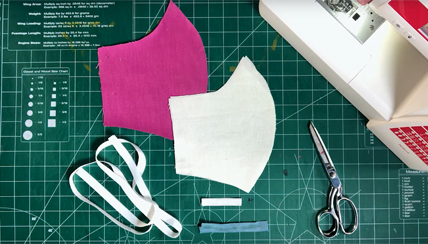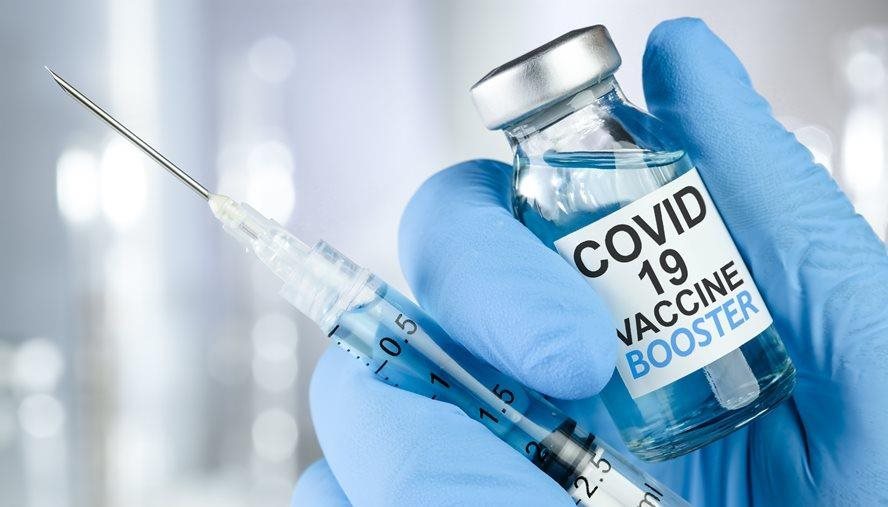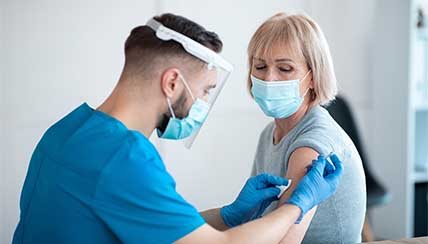Mask Making FAQs
 How did you come up with this mask design?
How did you come up with this mask design?
We reached out to the sewing community and sampled designs from the internet that seem to be most widely circulated among hospital groups and sewing groups in the United States. We then selected designs to prototype based on mask fit (i.e., the presence of a top wire to conform to the nose and an effective tie mechanism) and masks already widely produced through mask campaigns. We recruited local sewers to produce prototypes, had them optimize these as they saw fit, and then reviewed the masks with our Division of Environmental & Occupational Health Science.
Several masks were made by more than one sewer so that we could compare inter-sewer variability in mask production and our initial design was tested on National Jewish Health employees. We believe this design met our criteria for fit, comfort, and filtration efficiency (as much as may be possible with a cloth mask). This design is found on our webpage here: http://njhealth.org/makingmasks.
I have already made cloth masks but another pattern. Can I donate these?
Yes! We would appreciate the help and donation of cloth masks. Thank you.
Can I use the design from Saint Joseph Hospital?
Yes! We are proud of our sister hospital and their mask campaign. They are also developing a traditional style surgical mask, and are making masks to benefit Saint Joseph Hospital in Denver and other SCL Health facilities. For more information on how to help, check out their website at http://operationwecansewit.com.
What about a mask with a filter pocket?
Our preliminary guidance for homemade masks would be that fit is important and a nasal bridge wire (copper or wire ribbon, for example) that helps conform the mask to the face is crucial in optimizing filter efficiency. The material is important. Published studies suggest using two layers, preferably with a tight weave and 100% cotton. There are several groups making a pocket in the mask to be able to insert a filter, and this is a reasonable strategy, provided we can obtain the filter material. Furthermore, how this pocket should be used (i.e., how frequently to change the filter, what to use, etc.) is not known at this time. Ongoing studies will continue to look for ways to optimize our design.
Why can’t I use elastic for the ties?
We learned that the types of elastic found at fabric stores have variable thicknesses and tensile quality and do not always fit every face. We chose a mask that had a tie mechanism to allow for more adjustability on each user.
Are these masks meant to be disposed of after each use or used repeatedly?
These are meant to be used repeatedly with proper washing.
How should the masks be washed?
We recommend washing in hot water with unscented detergent and drying completely using medium to high heat.
I’ve heard cloth masks are unsafe. Why are you asking for cloth masks?
Cloth masks do not provide the same protection as traditional personal protective equipment (PPE). They should not be worn by health care professionals (HCP) when caring for suspected or confirmed COVID-19 infected individuals unless there are absolutely no masks available. Currently, all of our health care workers who interact with patients are provided surgical masks.
Cloth masks are the last option in the CDC’s recommendations when facemasks are unavailable and all other options provided by the CDC have been exhausted. However, the cloth masks do offer an important function even before we hit that crisis strategy. They are thought to serve as a barrier, for those people who may be symptomatic or who are asymptomatic carriers of the infection, particularly of larger-sized viral particles. This includes patients and other staff who work on the hospital campus outside of direct patient care. Being able to offer cloth masks to individuals who have the potential to be infected is a valuable initiative.
Importantly, ALL masks must be used properly. You must wash your hands before and after handling the mask. Once the mask has been worn, you should try to avoid touching the mask and or putting the outside surface against other surfaces. The mask needs to be laundered daily and anytime it is soiled or saturated. Additional details are included in our video.
Why do you recommend cotton for material?
An article by Davies and colleagues in Disaster Medicine and Public Health Preparedness tested the efficacy of homemade masks to see whether they would protect users in an influenza pandemic (Davies et al., 2013). In this report, they tested various materials for filtration efficiency (FE, or how well the material removed particles) and found that, compared to the surgical mask (on average 96% FE for a bacteria) the next best materials at filtering out particles were:
- a vacuum cleaner bag (95.35%, SD 0.74)
- a tea towel (83.24%, SD 7.81)
- a cotton mix cloth (74.60%, SD 11.18,
- a two-layer 100% cotton T-shirt (70.66%, SD 6.83).
Interestingly, pillowcase and antimicrobial pillowcase, linen, and silk all had lower FE or were less efficient at filtering than the materials above. They then tested a double-layer 100% cotton material as follows: 21 volunteers made masks according to a uniform pattern using sewing machines and then tested fit and effectiveness in preventing droplet and aerosol dispersal compared to surgical masks. While both masks significantly reduced microorganism transmission through the material the surgical mask was three times more effective than the homemade mask.
The authors conclude that “the homemade mask should only be used as a last resort … but it would be better than no protection.”
What about making masks from operating room (OR) surgical instrument wrap?
This is a great idea, and we have heard of hospitals doing this. We have not seen them ourselves and do not have access to OR surgical instrument wrap, but again, in the proper setting, and with availability of supplies, this may be an excellent option.
You say there are safe ways to use the mask. What does this mean?
Please see our link on using masks here: link
For a short video, please see here: link
What if I want to make this mask and use it myself of gift to our local healthcare professionals?
We are happy to share our design. We ask that if you do this that you include this instruction sheet with the mask for whomever will use it.
This information has been reviewed and approved by Marjorie Patricia George, MD, Jared J. Eddy, MD, Lisa A. Maier, MD, MSPH, FCCP (April 2020)
| The information on our website is medically reviewed and accurate at the time of publication. Due to the changing nature of the COVID-19 pandemic, information may have since changed. CDC.gov and your state’s health department may offer additional guidance. |


